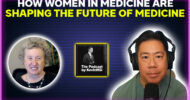Students have been sharing with me their reasons for deciding to pursue a career in internal medicine, a fitting topic for this year’s upcoming Internal Medicine Day. The most moving stories are those describing them seeing the person behind the patient, often for the first time.
Many students also mention, of course, their attraction to solving puzzles, the thrill of making a diagnosis, and their desire to have impact, wanting to change the practice of medicine for the better. All of this bodes well for the internal medicine physicians of the future.
Many of the students at our medical school have an engineering background, and one of the soft concerns expressed early on was “but will the students be able to take care of patients? How will they connect with patients, since after all, they are fundamentally engineers?” This, of course, reveals a blatant bias about the skill set and behaviors of engineers (full disclosure, I am married to one). One leading national faculty member even warned us, that in their experience, medical students with engineering backgrounds either are spectacularly good or amazingly, not so good. I am pleased to report that indeed our students have heart and soul. Moreover, they are as dedicated to the compassionate care of patients, and can express this, just as well as other more “traditional” students.
Some of the stories I especially love hearing from our students are those about their connections with patients, and how and why they found these experiences meaningful. Often the students were moved, either by seeing a patient in a new and unexpected way, or by recognizing how the simple ways they contribute, such as sitting and listening, can have a profound effect on a patient. Patients frequently express gratitude, having valued the students’ time, concern, and attention. There is something precious, dare I say sacred, about these early connections our medical students make with patients.
Their stories are numerous.
There is the one about a man with chest pain, who opened up to the student about the recent loss of his wife and his overwhelming grief; he had not shared this with anyone, and certainly not to anyone in the hospital. He thanked the student for listening and for making him feel comfortable enough to speak up.
There’s another story about a patient the student came to know well during a multi-week hospitalization. The student helped coordinate an in-hospital party for the patient, and they were delighted to bump into each other in the community after the patient’s discharge.
And another story, one about a patient with a severe pain disorder, who was eventually discharged with greatly improved pain and spirits. The student was their detective and advocate, helping to coordinate their work-up with specialists and ensuring they had appropriate resources during and after their stay in light of their uninsured status.
As we all know, many such moments will continue to occur throughout our students’ careers. The rewards lie in the relationships we build with patients, learning who they are behind the veneer of their disease, and realizing that our efforts to care make a difference, even if the outcome is not what we had expected or hoped. All of this is what our students are coming to appreciate. Medicine is not black and white. This is the challenge and beauty of internal medicine.
Our students are telling stories, and their stories remind us of the importance of human connection in patient care. Their stories also remind us of the mission of the American College of Physicians, “to enhance the quality and effectiveness of health care by fostering excellence and professionalism in the practice of medicine.”
Stories carry power, and all of us have stories to tell, whether we are students seeking a residency or are physicians who have been in practice for decades. Stories make our messages come alive. In primary care, we know our patients, and can use storytelling as a tool, permitting us to be our patients’ advocates. On behalf of our patients and for our patients’ futures, we must all use our voices as storytellers, especially today.
It is time to celebrate Internal Medicine Day, and the future of our profession as represented by our rising students. We celebrate and thank our students, our residents, our fellows, and our colleagues. We thank our patients, our most important teachers. We tell their stories, because our commitment to serve our patients remains steadfast. And we tell their stories, because we care.
Janet A. Jokela, MD, MPH, completed her term as ACP Treasurer at IM 2025. She serves as professor and senior associate dean of engagement at the Carle Illinois College of Medicine, Urbana, IL. She may be reached on BlueSky @drjanetj.bsky.social.
The American College of Physicians is the largest medical specialty organization in the United States, boasting members in over 145 countries worldwide. ACP’s membership encompasses 161,000 internal medicine physicians, related subspecialists, and medical students. Internal medicine physicians are specialists who utilize scientific knowledge and clinical expertise for diagnosing, treating, and providing compassionate care to adults, spanning from those in good health to individuals with complex illnesses. Stay connected with ACP on X @ACPIMPhysicians, Facebook, LinkedIn, and Instagram @acpimphysicians.




















![How algorithmic bias created a mental health crisis [PODCAST]](https://kevinmd.com/wp-content/uploads/Design-1-190x100.jpg)


